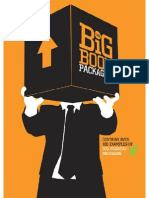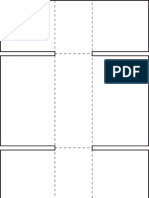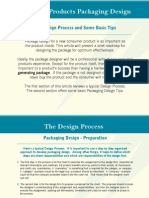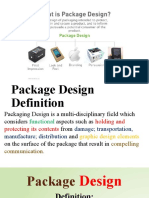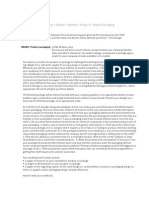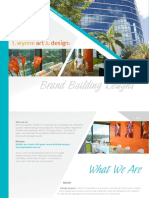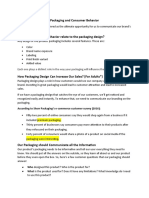80%(5)80% found this document useful (5 votes) 2K views209 pagesPackaging Essentials
Book about packaging design
Copyright
© © All Rights Reserved
We take content rights seriously. If you suspect this is your content,
claim it here.
Available Formats
Download as PDF or read online on Scribd
Packaging
Essentials
100 DESIGN PRINCIPLES FOR
CREATING PACKAGES
\
Sarah Roncarelli and
Candace Ellicott
er ee ey�Packaging
Essentials�© 2010 by Rockport Publishers, nc
Allrghts reserved. No part ofthis book may be reproduced in any form without
written permission of the copyright owners. Allimages in this book have been
reproduced with the knowledge and prior consent of the artists concerned, and
no responsiblity i accepted by produce, publishes, or printer for any infringement
of copyright or otherwise, arising from the contents ofthis publication. Every
effort has been made to ensure that credits accurately comply with information
supplied. We apologize for any inaccuracies that may have accurred and will re
solve inaccurate or missing information In a subsequent reprinting ofthe book,
First published inthe United States of America by
Rockport Publishers, a member of
‘Quayside Publishing Group
100 Cummings Center
Sulte 4064
Bevery, Massachusetts 01915-6101
Telephone: (978) 282-9590
Fax (978) 283-2742
worwrockpub.com
Library of Congress Cataloging-in- Publication Data
Ellcot, Candace
Packaging essentials: 100 principles for package design / Candace Eliott and
Saran Roncare!
p.m.
|SBN-13:9784-59253-603-0
ISBN10: -59253-603-4
1. Packaging-Design. |, Roncarel Sarah I Title. Title: 100 principles for
package design lV Tile: One hundred principles for package design.
NcIO02.P33E45 2010,
1452-de22
2008052403
cP
IsBN-13:9781-59253-6020
ISBN-10: +59253-603-4
w9a7654321
Design: Sarah Roncarell and Candace Elicott
Printegin China��Packaging
Essentials
100 DESIGN PRINCIPLES FOR
CREATING PACKAGES
iuoduoon
Sarah Roncarelli and
Candace Ellicott�DEDICATION
Mae-Lynn is a pest.
She is also a loveable and gentle soul. With the effectiveness of
‘a Hot Shot cattle prod, Mae tirelessly corralled package designers
from around the globe and made this book one that inspires and
teaches by example,
\We are eternally grateful for her project leadership, meticulous at-
tention to detail, good humor, and exceptional organizational skills
She is a model of grace and individualism and lives by an impossibly
strong work ethic.
|We dedicate this book to her for all her efforts. Plus, we want her
to accept a full-time position at Fifty and thought that dedicating
‘a book to her might persuade her.�Contents
IntRoDUCTION,
es
‘THE DESIGN CHALLENGE
1.Get the bret right.
2. Design for the customer,
ot for YOU nn 2
3. Organizing @ product range. 14
4. Designing for a private abel nen
‘5. Designing for display:
6. Relevance in package design.
DESIGN CONSIDERATIONS: MATERIALS
T.Reseateh the OBtONS evennnns 22
8. Glass and bottle design... 2a
9. C210 00d nnn 26
10. Metal. en 2B
1. Paste,
‘2.Wrappers. ee)
1, Innovative materials
DESIGN CONSIDERATIONS:
FORM AND SHAPE
14. Brand guidelines that
Includes pen
15 Form defines function, and
Function defines ft ween 38
16, Designing 8 B39 venir
(Mosel a2
(ee Aa
19, Special F105 nn a6
20, Window reveals.
Ano 48
DESIGN CONSIDERATIONS: LABELS
22. Designing a label oe)
23,shapes. —— s2
24, Label fVEaIS 294 TOS nnn
DESIGN CONSIDERATIONS: PRINTING
25. Fourcol0r IthogF3p Ny nn 8
26, Lithography with three
or fewer colors a)
27 Flex09F2PH on snnnnnnnnnnns6O
Seng ry
29. Screen printing, vn
30. Special techniques:
Special inks and varnisheS nena 66
31 Special techniques: Fil stamping nw-6B
MARKETING AND BRAND
CONSIDERATIONS
32. A package a5 2 3leS 1001 nnn TO
33, Demographics an
234, Psychographi¢snsnennsenn�35, Designing within a brand standard....76 THE DESIGN PROCESS 83, Fonts create mood and character wun 72
26, Masti pataging 7858. Crsteanentonl amen 2 94 Handmade ype rm
B.natsina ae even) $9,T8L Aor 12485. 1)pea8imaer. 6
26. acasng mass 626. seting teat tone 1266, om ther ng 8
PLEAD, Bey, NN ee 6 Pld, 128 ar ads and imran
40. Technology - {86 62. Metaphors and similes. 130 {nformation reo
41. Confection and candy. - 88 63. Humor and wit. Se wee
42, Wine and spirits. - 90 64. Provide information 134 8°. Product protection et
43. Beverages. 92 65. The art of exaggeration. ee a
44, Books and media, . 94 66. Fake it with faux. Gp alt ela 188
45, Fashion 96 67. Achieving balance. ce
sed eee 88 68:Eore pate pq eneretva paces wo
Ar ae an arden event0068.Rlesand ines Oo oe
48 id procs 102 70.Faming and drawing "ae acne adbons 194
{9.0tceandt suppeS omen 104 —Teleonoaraphy and s¥mbotsMnmann8 95, reoking theres 16
50. et routs 105 72, Wott nd rains 1s0
St Ad oy 108 TE. PhLOGA nen 152 ASSESS AND REVIEW
4 Reto des, 15496 Paatng nd mating ean 98
SUSTAINABLE DESION "taal of lr 156 9.Gaieng 1 sen 200
£2. Sista pacts O76. Lackof olor 15896. Ancsting he rnd oro 202
52. Sista print 12 Te Abindance fet 160 98.custmer research 204
SA at pos 1 78Do hide th substrate 162100, ceerate a sxccsre
‘55. Paper options. Né 79. Minimalist design. lea Tceattenal a
56, Mie 984095 eceeenenet® 80, Constr al sides 16
‘57. Biodegradable and 81. Hierarchy and dominance. jeg CONTRIBUTORS momen 206
reyelbie pacages a tno. ABOUT THE AUTHORS 208
a Uy
: “ae =
by 2
nae�Introduction
Thinking about the first package ever, we imagine a burly,
premedieval nomad, nursing a mug of mead by a smoldering
fire, gloomily pondering the prospect of leaving behind what's
left of his hard-won roasted wild boar. Necessity called for
invention, and packaging was born.
In those early days, package design was limited to the
hollowing out of a gourd or the drying of an animal pelt
[As centuries passed, paper, wood, ceramic, bronze, and iron
all served thei time as packaging materials.
Inthe early 1900s, sclantists realized that sealing food in tin
extended the life of the product. Food manufacturers realized
that tinned food would sell better i it had their name on it
'As marketing and printing techniques advanced, designers
began to examine the effect of typography and decorative
design on product sales and they were pleased with the results
For today's package designer, creativity knows no bounds.
There are limitless technologies, resources, and skis that
can be applied to the design of packages to great effec. Every
{great designer knows that in each package design project there
's opportunity-an opportunity that must be searched for, battled
for, wrested to the ground, and ceremoniously won.
sPacanng sents
‘The designer's mastery of package design skills such as
typography, color, design pattern, photography, and illustration
are calles upon in this encounter, but equally sos the ability
to.connect the product and consumer through an idea.
‘The package designer's idea-generation process is complex.
Its a tennis game between the practical and the impossible,
the emotions and the logical, the tried and true, and the
wild, new frontier. tis a precarious balance of opposites
signed to engage consumers consciously and unconsciously.
‘The designers wil inevitably consider the experience of the
package and the unveiling of the product inside.
This book makes the case that great design is inspired design.
Its filled with examples of inspiring package design, design
features, applications, and useful tips. You wil se the work
of those who followed the rules of design to the letter and
of those who broke the rules with abandon. Designing for
packaging is painstakingly hard work. The reward of which
Is not just @ package that entices consumers to pick up, sniff
‘examine, and ultimately buy, but a powerful brand experience
that ensnares a consumer's loyalty for ite�“lam always doing that
which | cannot do, in order
that | may learn how to
do it.” —Pablo Picasso�Get the Brief Right
‘The design briet helps the designer understand his ‘must explain how the package's progress willbe managed
Ciient’s marketing and sales requtements, 2s well as through the manufacturing, warehousing, distribution,
manage the relationship. The client brief should cover and shelving process in the most costefective manner
brand, manufacturing, and audience perception concern.
It should define all rand isues such as category Finally the design brief must articulate how the packaging
competition, design standards, andthe audience factors __will present the product's most saleable features and how
‘that alctate a specific design treatment orcection.t itil attract consumers in the most convincing way
Let)
Cor)��Design for the Customer, Not for Yourself
Iaealy a package design contributes to postive inter
‘action between a product and its consumer. To facilitate
this interaction, the successful package designer wll
understand the auaience’s personality, values, attitudes,
interests and ifestyle-in other words, the psychograpics.
Psychographies help designers visualize and empathize
vith the consumers they are designing for so that tney
‘an create an emotional connection between the product
‘and the buyer.
Produ the page design
Cigntoen Super Fu {
retoroaininece pte aasess
re potas. Thee conte
2s hey weren't pacaged as
Feet Secon lor Saja
Designers must also understand the demographics of
their audience, which provide information on race, age,
income, disabitties, mobility, educational attainment,
home ownership, employment status, and even geo
‘graphic location. Demographic information guides
designers decisions on packaging size, cost, unctionallty,
Information, ang creative direction��‘A welldesigned product ine appeals toa broad range of
‘audience segments while preserving the brand character.
The product ine is extended by varying the brand theme
but staying true to commonalities within the brand's
core attributes.
Design devices tobe utilized in the extension of a product
tne include the flowing
+ Colo: This isthe fst design element consumers observe
It makes the strongest impact. Color changes should be
reserved for only the highest level of diferentation.
eres
co
ia)
Organizing a Product Range
+ Shape: This is 2 powertl brand identifier. Package shape
should not vary dramatically
+ Graph elements: Things such as logos and ilustrations
‘anchor the brand inthe audience's mind. Minimal variation
can occur here, as long as commonality Is retained.
+ Numbers: These are an effective way to aifeentiate the
brand. For example, many car brands have successfully
extended ther product line with a numbered serles such
{8 200, 300, and 400.
+ Words: These ae the least powerful communicative
devices, Words are what a consumer looks to last to
Understand a brand. The designer should not rely on
‘words alone to delineate a branded product tne.��THE DESIGN CHALLENGE
4 Designing for a Private Label
Profet
ean an pata design
Mateo Elona,
eta ocry tore mown or
Is kau fds an utstnding
out trandtor some
felctiam of the mara. the
ith a omer visual engage
supersized rapes to ea
trond experince
seperti Essent
Today, the private-label industry is worth mare than
{USS400 bition globally, wth the highest penetration in
the food industry.
‘Years ago private label packages hada very basic look. In
fact many packagers engaged in copycat package design
‘to mirror national brands. Today, privatelabel package
designers use high-end graphic design techniques to
estaolish the brand and identity for product lines. In
addition, private labels are forecast to make even greater
inroads inthe next few years in other product categories
besides food, incling organic foods, pet foods,
cosmetics, and pharmaceutical products.��Designing for Display
Shelf space isthe primary intersection between products
and consumes in the retail environment. The designer must
‘make optimum use of this costly realestate. Vertical as
‘opposed to horizontal package orientation wil allow for a
higher concentration of products. However, inthe end, the
store merchandiser chooses how the store wll display the
product based on the store's agenda, The designer should
spend time inthe retail environment to appreciate the
complexity of the display challenge before beginning the
design process.��Relevance in Package Design�Project
roam pctae sean
Sumer bucworth,
Design Tom
re Doctor
Shawn Rosenberger
Cent
‘ns new weight management
raya is dered to fcuson
sor ee weigh The name
suggests te ease ote program
hla petiole estat
{nd desea reection of nches.
carries out bythe measuring
‘ape graphic on ne pachage�Research the Options�-
ALUL 6 REAL
|�Glass and Bottle Design
‘lass isnot the lghtest of packaging materials but itis often
‘chosen for its strength and clean appearance, Many product.
categories, such as pharmaceuticals, beauty products, and
food products, use alass packaging.
‘lass isan energy-intensive package to produce, but i is
100 percent recyclable, The raw materials in glass consist
of cule, sand, limestone, and soda ash, making it highly
sustainable and impervious to the market volatility of ci
based products
Glass comesin a variety of colors, such as amber ana green
which are ideal or protecting loht sensitive products. Gass
also comes ina variety of sizes and shapes. Shapes can be
chosen from a catalog, ora designer with a higher budge!
can develop a customized glass shape. To brand or mark
a glass package the designer can explore label design as
Well as etching and silescreening techniques. Designers
can also explore a varity of textured glass surfaces, such
as frosted or sandblasted.��Cardboard
Cardboard can be used for fine, upscale packages, coarse
‘outer packs, freezer packs, and utiltarian or highly designed
package treatments. Carcboard options also include 3
choice of texture, surface coating for printing, and weight
variations whic affect the caraboards wet strength, When
printing on uncoated cardboard, the designer must be sure
te consult the printer for information an dot gain
Designers have many choices for designing wit cardboard,
but itis important to chaose the right kindof carcboar fo
the Fight jo
+ Solld bleached sulfate is premium, coated board that
contains 80 percent virgin bleached wood pulp. is
used for medical packaging,
‘rink boxes, cosmetics and perfume packaging, and
frozen food packaging,
+ Coated unbleached Kraft paperboard contains atleast
80 percent viegin unbleached, natural wood pulp. Is
coated to improve its printing surface and wet strength
Its used for frozen food packaging, milk cartons, and
pharmaceutical packaging
ilk and juice cartons,
+ Uncoated recycled paperboard is produced from 100,
percent recovered paper. Some uncoated paperboard is.
produced with atop ply of white recovered fiber, or is
vat dyed for color, itis used for shoeboxes, composite
cans, and fiber drums
+ Coated recycled paperboard is produce from 100
percent recovered paperboard and is
layer of kaolin clay over a top ply of white recovered
five, tis used for soap and laundry detergent
packaging, cookie and cracker packaging, facial tissue
{and napkins, cake mix packaging, and cereal boxes.
+ Corrugated board is used for transport packaging for
furniture and large appliances. Packagers choose
the kind of paperboard to be used in accordance
with transportation, weight and strength, and shock
absorbency requirements.
+ Bleached paperboard isa premium paperboard grade
that is used widely n the food and consumer goods
industries. i's known fr Its folding and searing properties.
ated with a thin�onion
aes
BAGS OF OUR.
iURADEY
EVERYDAY
TEA�Metal
It is easy to see why metal has been sitting on grocery
store shelves for decades, Metal gives products 3 minimum
het life of three years. tis 2 renewable material and
infinitely recyclable without a oss of quality. Metals inherent
robustness provides protection during transportation, so
litle secondary packaging is required.
‘Tin was historically used for metal containers, Now stainless
steel and aluminum are the main metals used to protect
food against environmental contaminants. Stee is used for
Camel Svs Comsany
Aner upta tsok witout
doa Esetals
vacuumpackaged foods such as vegetables, condensed
mil, fish, fruits, nuts, and pet foods. Aluminum is used to
package beer, soda, and carbonated beverages as well as
‘deodorant, cooking sprays, and spray paint,
From a design perspective, metal canbe printed on or abels
can be used to deliver packaging information. Designers
can choose metal containers from a catalog or create
designs of their own,
sSsouP)/
Cae Ce
Tomato’ Tomato’,
: Ga SOUP?’�vaL ONIOV ILNV�Plastic
Plastic can be used to display, contain, and protect a product.
For branding purposes, plastic can be printed on directly
with a muttude of textures and techniques. Alternatively
2 plastic sleeve can be produced witha hest-sealed film
that i printed and then slipped over aplastic container,
A wide variety of plastic materials is used for packaging:
+ Polystyrene the bass for Styrofoam. Foam bubbles are
synthesize in an open or closed air cell and hardened,
Styrofoam is used extensively to protect nonperishable
Products and food,
+ Clear plaste blister packs are used witha cardboars
blister card that makes it easy for the customer to see
the product, Parmaceutical capsules and cough meslcine
capsules use blister packaging,
PVC is softened through a chemical process and used for
shrink-wrap and food packacing
+ Clamshells are clear plastic boxes, perfect for products
that benefit from being seen by the customer, Electronic
Products, toys, fod, and afce supplies are often packaged
in clamshell as they'e aif to open and are a deterrent
to shopiiters.








